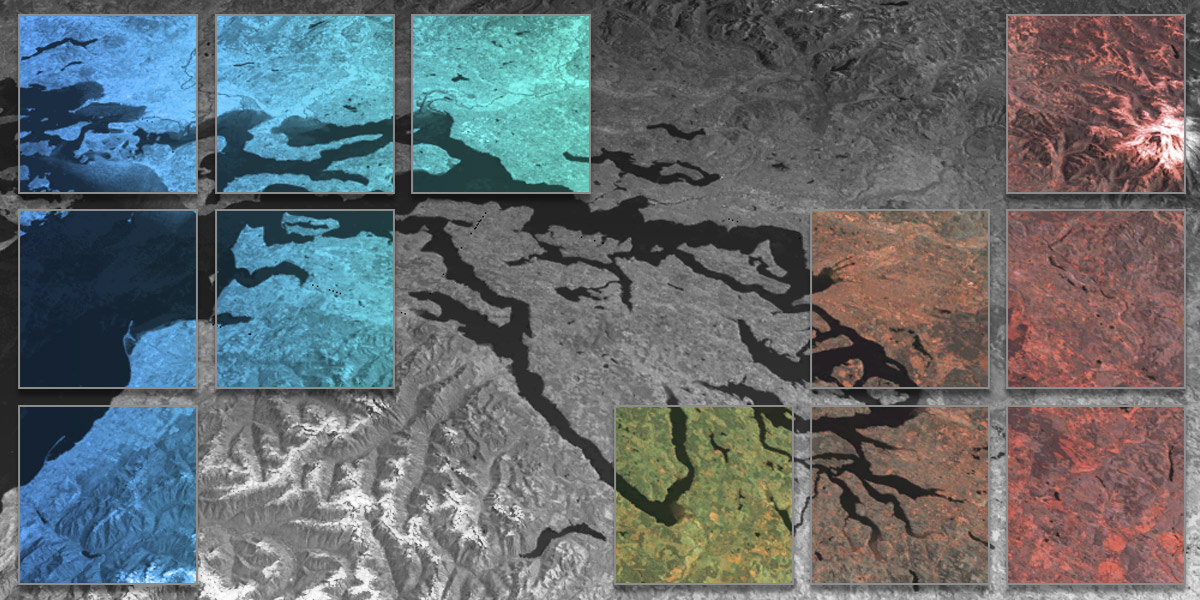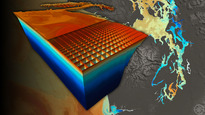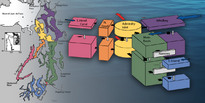Numerical Models

An integrated Regional Synthesis Model
Physical Template
This fluctuating template forms the geometry upon which all our biophysical processes are mapped.
Puget Sound and the associated inland marine waters of northwest Washington State are a large estuary complex, carved by glaciers, receiving runoff from the encircling Cascade and Olympic mountains. Puget Sound is surrounded by approximately 2,500 miles of shoreline; a mosaic of beaches, bluffs, bays, estuaries, mudflats and wetlands. The waters of Puget Sound reflect a mixing of salt water from the ocean with fresh water that falls as precipitation or drains from the surrounding land. More than 10,000 streams and rivers drain into Puget Sound. (from: http://www.psat.wa.gov/Programs/salmon_recovery/section2.pdf)
The conceptual framework that underlies the collaborative nature of all PRISM products is that they all occur upon this physical template. While often thought of as a stable unchanging landscape, PRISM recognizes the physical template as a geometry in constant change. This fluctuating template forms the geometry of Puget Sound upon which all our biophysical processes are mapped.
Landsurface Dynamics
The Puget Sound region is recognized as a dynamic landscape. Bounded by sub-alpine meadows of the Cascade and Olympic mountain ranges, the Puget Sound ecosystem transitions through numerous terrestrial and aquatic ecoregions. Changes in these regions occur on a variety of spatial and temporal scales; from precipitation and land surface runoff to biogeochemical cycles, which relate to the productivity of our landscape and habitat selection by various species.
Modeling of land surface dynamics requires an integration of ecological process models with numerous observational data. PRISM initializes the science of land surface dynamics following the pathways of the hydrological cycle. The interaction among processes such as; evapotranspiration, soil moisture, surface runoff, bioaccumulation, and instream flow forms is captured in the Distributed Hydrology Soils and Vegitation Model. Learn More.
Marine Dynamics
The circulation and mixing of water in the Sound fundamentally controls its biogeochemical processes, from planktonic primary production to the transport of toxics. The Sound's size, intense tidal currents, and extraordinary rough glacially-carved bathymetry present real challenges to even our state-of-the-art numerical modeling capabilities.
The current phase of PRISM circulation modeling, being led by Dr. Parker MacCready and Dr. David Sutherland (UW Oceanography) is using intensive parallel computation to significantly increase both the resolution and the domain size covered by the model. Current efforts are underway to optimize the model set-up, validate the model against the available observations, and begin to answer scientific questions about how the Sound works, from daily to decadal timescales. Learn more.
Atmospheric Dynamics
Modeling atmospheric circulation and region scale meteorology. The Fifth-Generation NCAR / Penn State Mesoscale Model (MM5) is the latest in a series of limited-area, hydrostatic or nonhydrostatic , terrain-following sigma-coordinate models designed to simulate or predict mesoscale and regional-scale atmospheric circulation. The Department of Atmospheric Sciences at the University of Washington is now running version 3.7.3 (MM5 v3.7.3) twice a day in order to produce high resolution meteorological forecasts for the Pacific Northwest.
Within the PRISM framework, surface output of MM5 is used to provide input for both the land surface hydrology model(DHSVM) and the marine circulation model (POM). As one of PRISM's earliest partnerships, which is still vital today, PRISM's support of graduate student allows the pursuit of the interdisciplinary studies in the field of atmospheric modeling.
Salmon Life Cycle
SHIRAZ is a framework for integrated analysis of habitat, hatchery, and harvest impacts on salmon. The origins of the model date back to the early 1980s when graduate students at the University of Washington led by Ray Hilborn, Professor of Aquatic and Fishery Sciences, in coordination with the Muckelshoot Indian Tribe, developed a conceptual model of impacts to habitat and the subsequent affects on salmon population. The model is basically a guided worksheet used to organize the existing knowledge related to the capacity and productivity of streams and their impacts on salmon survival.






